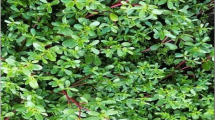Abstract
Acute oxalate nephropathy is a rare but important cause of severe acute kidney injury. We report here two cases presenting as unexplained AKI which were confirmed histologically to be due to acute oxalate nephropathy. Dietary oxalate or its precursor vitamin C was the cause of oxalate exposure in both of these cases. While one patient recovered, another continued to need dialysis and succumbed to underlying metastatic cancer. This cause should be suspected in all patients presenting with unexplained AKI, and detailed history about dietary intake of oxalate or vitamin C should be inquired.


Similar content being viewed by others
References
Rosenstock JL, Joab TMJ, DeVita MV, et al. Oxalate nephropathy: a review. Clin Kidney J. 2021;15(2):194–204.
Cochat P, Liutkus A, Fargue S, et al. Primary hyperoxaluria type 1: still challenging! Pediatr Nephrol. 2006;21(8):1075–81.
Buysschaert B, Aydin S, Morelle J, et al. Etiologies, clinical features, and outcome of oxalate nephropathy. Kidney Int Rep. 2020;5:1503–9.
Lamarche J, Nair R, Peguero A, et al. Vitamin C-induced oxalate nephropathy. Int J Nephrol. 2011;2011:146927. https://doi.org/10.4061/2011/146927. Epub 2011 Mar 16
Jaeger Ph., Robertson WG. Role of dietary intake and intestinal absorption of oxalate in calcium stone formation. Nephron Physiol. 2004;98:64–71.
Getting JE, Gregoire JR, Phul A, et al. Oxalate nephropathy due to ‘juicing’: case report and review. Am J Med. 2013;126:768–72.
Curhan GC, Willett WC, Rimm EB, et al. A prospective study of dietary calcium and other nutrients and the risk of symptomatic kidney stone. N Engl J Med. 1993;328:833–8
Hellman L, Burns JJ. Metabolism of l -ascorbic acid-1-C 14 in man. J Biol Chem. 1958;230 (2):923–30.
Blanchard J, Tozer TN, Rowland M. Pharmacokinetic perspectives on megadoses of ascorbic acid. Am J Clin Nutr. 1997;66:1165–71.
Thomas LD, Elinder CG, Tiselius HG, et al. Ascorbic acid supplements and kidney stone incidence among men: a prospective study. JAMA Intern Med. 2013;173(5):386–8.
Harambat J, Fargue S, Acquaviva C, et al. Genotype–phenotype correlation in primary hyperoxaluria type 1: the p.Gly170Arg AGXT mutation is associated with a better outcome. Kidney Int. 2010;77:443–9.
Mukattash TL, Alkhalidy H, Alzu’bi B, et al. Dietary supplements intake during the second wave of COVID-19 pandemic: a multinational Middle Eastern study. Eur J Integr Med. 2022;49:102102. https://doi.org/10.1016/j.eujim.2022.102102. Epub 2022 Jan 12. PMID: 35039757; PMCID: PMC8754456.
Author information
Authors and Affiliations
Corresponding author
Ethics declarations
Conflict of interest
None (attached the form).
Ethical approval
All procedures performed in this report were in accordance with the ethical standards of the institute and with the 1964 Helsinki declaration and its later amendments or comparable ethical standards.
Informed consent
Attached.
Additional information
Publisher's Note
Springer Nature remains neutral with regard to jurisdictional claims in published maps and institutional affiliations.
About this article
Cite this article
Bothara, R., Joga, A., Bose, S. et al. Acute oxalate nephropathy: exploring the role of excess dietary oxalate intake. CEN Case Rep (2024). https://doi.org/10.1007/s13730-024-00870-6
Received:
Accepted:
Published:
DOI: https://doi.org/10.1007/s13730-024-00870-6




